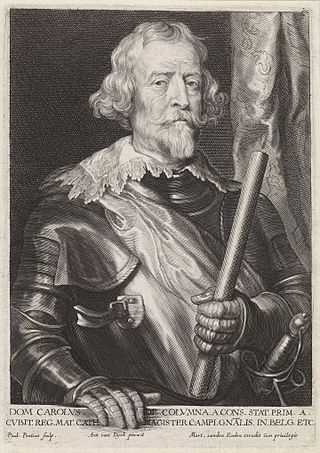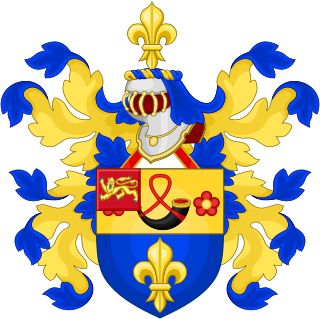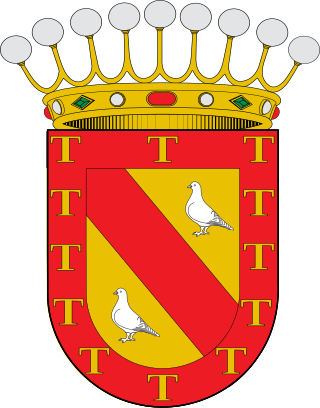
Spanish nobles are persons who possess the legal status of hereditary nobility according to the laws and traditions of the Spanish monarchy and historically also those who held personal nobility as bestowed by one of the three highest orders of knighthood of the Kingdom, namely the Order of the Golden Fleece, the Order of Charles III and the Order of Isabella the Catholic. A system of titles and honours of Spain and of the former kingdoms that constitute it make up the Spanish nobility. Some nobles possess various titles that may be inherited, but the creation and recognition of titles is legally a prerogative of the King of Spain.

Don Carlos II Coloma y de Saa, knight of Santiago, 1st Marquess of Espinar was a Spanish military commander, diplomat and author. He is also known as a translator of Tacitus.
Pedro Fajardo y Chacón, 1st Marquis of los Vélez, Grandee of Spain,, was a Spanish military and nobleman. His seat was at the Castillo de Vélez-Blanco.

The Marquess of Lede was a Flemish title in use during the Ancien Régime. Lede is a city in Flanders, Belgium.

Bornem Castle, also known as the Marnix de Sainte-Aldegonde Castle, is a country house, formerly a castle, located in Bornem, province of Antwerp, Belgium. Bornem Castle is situated at an elevation of 1 meters.
Juan IV Coloma y Cardona, 1st Count of Elda,, 3rd Sieur of Elda, Governor of Alicante Castle, Count of Elda, Viceroy of Sardinia, 1570-1577.

Count of Chinchón is a title of Spanish nobility. It was initially created on 9 May 1520 by King Charles V, Holy Roman Emperor, who granted the title to Fernando de Cabrera y Bobadilla.
The House of Silva is an aristocratic family of Spanish and Portuguese origin.
Pedro Ponce de León the Elder was a Castilian nobleman, great-grandson of King Alfonso IX of León. He was a knight of the Order of the Band, and Lord of Marchena, Bailén, Rota, Mairena del Alcor, Bornos and Oliva de la Frontera.

The House of Lannoy is the name of an old and important Belgian noble family that takes its name from the French town of Lannoy, Nord. The name comes from l'Annoy which means «the alderwood» in Picard French of Flanders.
Francisco Coloma y Maceda, Marqués of Canales de Chozas (1617–1677) was a Spanish oidor and licentiate who served as the 29th Governor-General of the Philippines. He is the fifth Governor-General of the Philippines from the Real Audiencia of Manila. Prior to being governor, Coloma served as senior auditor (oidor) in charge of military affairs during the administrations of Governor-General Diego de Salcedo to Manuel de León.

The Rubens family is a Flemish noble family that lived in Antwerp.
Emmanuel Coloma y Escolana, called Manuel, (1637-1713), is 2nd Marquess of Canales de Chozas and a Spanish Ambassador.
Jean Alphonse, 1st Count de Coloma, was a Flemish noble lord of Spanish descent, a member of the House of Coloma. He was a councillor on the Great Council of Mechelen and the supreme council in Vienna, and president of the Privy Council of the Habsburg Netherlands .

Juan II Coloma, 1st Lord of Elda, Salinas and Petrer, 2nd Lord of Alfajarin, also known as Mosen Coloma was a court functionary of the Spanish noble house.
The Lords of Corswarem are the heads of the noble house of Corswarem-Looz. The current Dukes of Corswarem are descendants of Lords of Corswarem. The current Duke, Thierry is the 11th Duke of Corswarem-Looz.

Count of Elda is a hereditary title in the Peerage of Spain accompanied by the dignity of Grandee, granted in 1577 by Philip II to Juan Coloma, who was Viceroy of Sardinia.

Don Pedro Coloma, Baron of Bornhem and Lord of Bobadilla, was a Spanish officer in the Army of Flanders who established a noble line in the Habsburg Netherlands, a branch of the famous House of Coloma.














